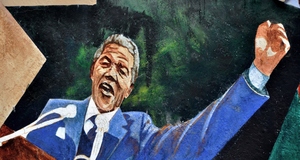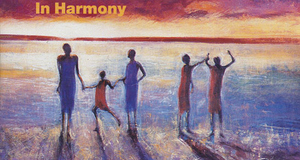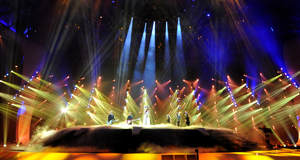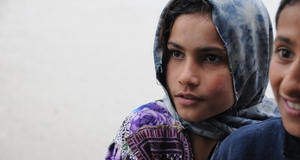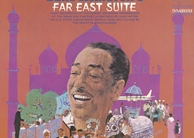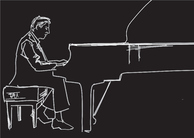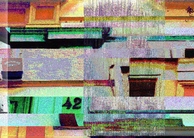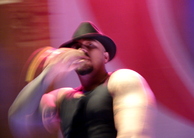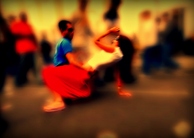Protest and Rock n' Roll During the Vietnam War
By
2012, Vol. 4 No. 11 | pg. 1/1
KEYWORDS:
In the 1960s, several now-influential artists appealed to the disaffected counterculture’s emphasis on peace and love, especially with the sliding approval rates of the Vietnam War. As public approval of the Vietnam War dwindled in the latter half of the 1960s, popular music artists began to record songs that reflected this disapproval and ultimately became a new method of protest. To begin, the highly-influential folk musician Bob Dylan recorded the song “The Times They Are A-Changin’.” Written in 1963, just before the public began to disapprove of America’s involvement in Vietnam, the song features a simple melody played by Dylan’s acoustic guitar and harmonica. The lines “There’s a battle outside/and it’s ragin’/it’ll soon shake your windows/rattle your walls” are an obvious reference to the Vietnam War. Dylan goes further and sings the lines, “Come mothers and fathers/throughout the land/and don’t criticize/what you can’t understand/your sons and daughters are beyond your command.” While at first glance Dylan could be pleading with the public to stop trying to understand the war, Dylan is in fact trying to tell us something else. In poetic terms, he shows the mass confusion, frustration, and anger at how many parents’ sons and daughters were sent off to war.Moreover, a 1966 anti-war music poster advertised the popular rock groups Jefferson Airplane and Mystery Trend. The event, a benefit dance held at the University of California at Berkeley on March 25, 1966, features a large war scene drawing at the center. The war scene, colored in red, white and black, features combatants wearing helmets and holding machine guns, while avoiding explosions triggered by bombers flying overhead. At the top of the scene, the words “Vietnam” can be seen in the same font that the military uses. Below “Vietnam,” the word “Peace” can be seen scrawled in white lettering. While the colors are not varied in the poster, they still capture the simple brutality of war, with the blood-red background and white sketches of soldiers. The scrawled words, often described as the pre-cursor to Psychedelic rock posters known as “tabletop-doodles,” show the simple message among common people that they want the Vietnam War to end. To attract other people to their cause, the concert promoters use popular musical artists to entertain and educate the masses on the anti-war efforts of the 1960s. Furthermore, John Lennon, an ex-band member of the popular rock group The Beatles, recorded a song called “Give Peace a Chance” in 1969. The popular song is essentially a live cut, recorded by crowding several people into a Montreal recording studio. Backed only by Lennon’s guitar, a tambourine, and the chants and claps of people, the song asks the listener to ponder the main chorus, “Give Peace a Chance.” While many of the lyrics are controversial in their approach, Lennon alludes to several popular key figures, including the aforementioned Bob Dylan. One verse alludes to the urgency for the United Nations to end the war when Lennon Sings, “regulation, integrations/meditations, United Nations/Congratulations.” The song is an effective and artful protest of the war, since everyone sings in harmony, showing how many people can find a common ground in their protest of the Vietnam War. In essence, the song is perhaps the simplest anthem of the late 1960s, appealing to everyone affected by the war. In addition, the August 1969 Woodstock Music festival is arguably the most influential musical event that spread the message of peace towards the close of the decade. Billed as “Three days of peace and music,” the event attracted several thousand concertgoers, mostly due to its vast lineup of several well-known rock artists. Perhaps the most memorable act came from influential rock guitar virtuoso Jimi Hendrix when he played a searing rendition of America’s national anthem, “The Star Spangled Banner.” The August 17 performance, which lasted just under five minutes, featured Hendrix manipulating his guitar’s sound by employing distortion and whammy-bar techniques. The end result was a remarkably realistic imitation of several war sounds, including machine gunfire and explosions. Just over halfway through the performance, Hendrix briefly plays the “Taps,” which is what the American Military plays during an honorary burial. By getting his anti-war message out through the unique manipulation of his guitar, Hendrix appealed to the thousands of concert-goers who came together for peace. Equally important, Edwin Starr’s Motown anthem “War” convinced many listeners of the complex horrors of the Vietnam War through an instantly-recognizable melody. The song, written in 1969, is perhaps the most direct anti-war protest song ever recorded. The song, a combination of Starr’s shouts and sudden rhythmic beats, is like a war scene in and of itself. The beginning verses, “War, huh, yeah/What is it good for/Absolutely nothing” speaks in general terms, but begins to become more specific. The harrowing lines, “War, it ain’t nothing but a heartbreaker/War, friend only to the undertaker” is a brutal reminder that war is a human conflict and kills many people. While many songs protesting the Vietnam War are rock-oriented, “War” crosses this genre boundary by being distinctly Motown. With this in mind, while many of the Vietnam protest songs were rock-oriented, many other artists could record songs that strayed from the rock genre and still capture an audience. Much of popular music in the 1960s was another means of protest for an audience that was against the Vietnam War. Several now-influential music artists used their talents to appeal to a wide audience that was against the war. This is shown through Bob Dylan’s “The Times They Are A-Changin’,” the anti-war concert poster at Berkeley, John Lennon’s “Give Peace A Chance,” Jimi Hendrix’s rendition of the “Star Spangled Banner” at Woodstock, and Edwin Starr’s “War.” Not only has music been a direct means of anti-war protest, but the culture of peace and love, seen especially in the Woodstock festival, has also pervaded the minds of the public. Posters advertised these artists and this culture by appealing visually to those that were against the war. Video clips, which are easily circulated, allow posterity to view how artists played their songs and how the audience reacted. While catchy melodies can capture a listener’s attention, the lyrics of the music spoke to the minds of a disillusioned generation. In many ways the 1960s represented the forefront of using music, and the accompanying culture, to speak out against war. References(1966). Anti-Vietnam war poster. Retrieved from http://images.google.com/images?gbv=2&hl=en&q=anti+war+vietnam+poster+music&btnG=Search+Images Dylan, B. (1964). The Times They Are A-Changin’. Retrieved from http://www.bobdylan.com/#/songs/times-they-are-changin Hendrix, J. (1969). JIMI HENDRIX-STAR SPANGLED BANNER/PURPLE HAZE AT WOODSTOCK. Retrieved from http://www.youtube.com/watch?v=jSi6RKvQfrw Lennon, J. and McCartney, P. (1970). “Give Peace A Chance.” Retrieved from http://www.brownielocks.com/givepeaceachance.html Starr, E. (1969). Retrieved from http://www.oldielyrics.com/lyrics/edwin_starr/war.html Suggested Reading from Inquiries Journal
Inquiries Journal provides undergraduate and graduate students around the world a platform for the wide dissemination of academic work over a range of core disciplines. Representing the work of students from hundreds of institutions around the globe, Inquiries Journal's large database of academic articles is completely free. Learn more | Blog | Submit Latest in Music |








